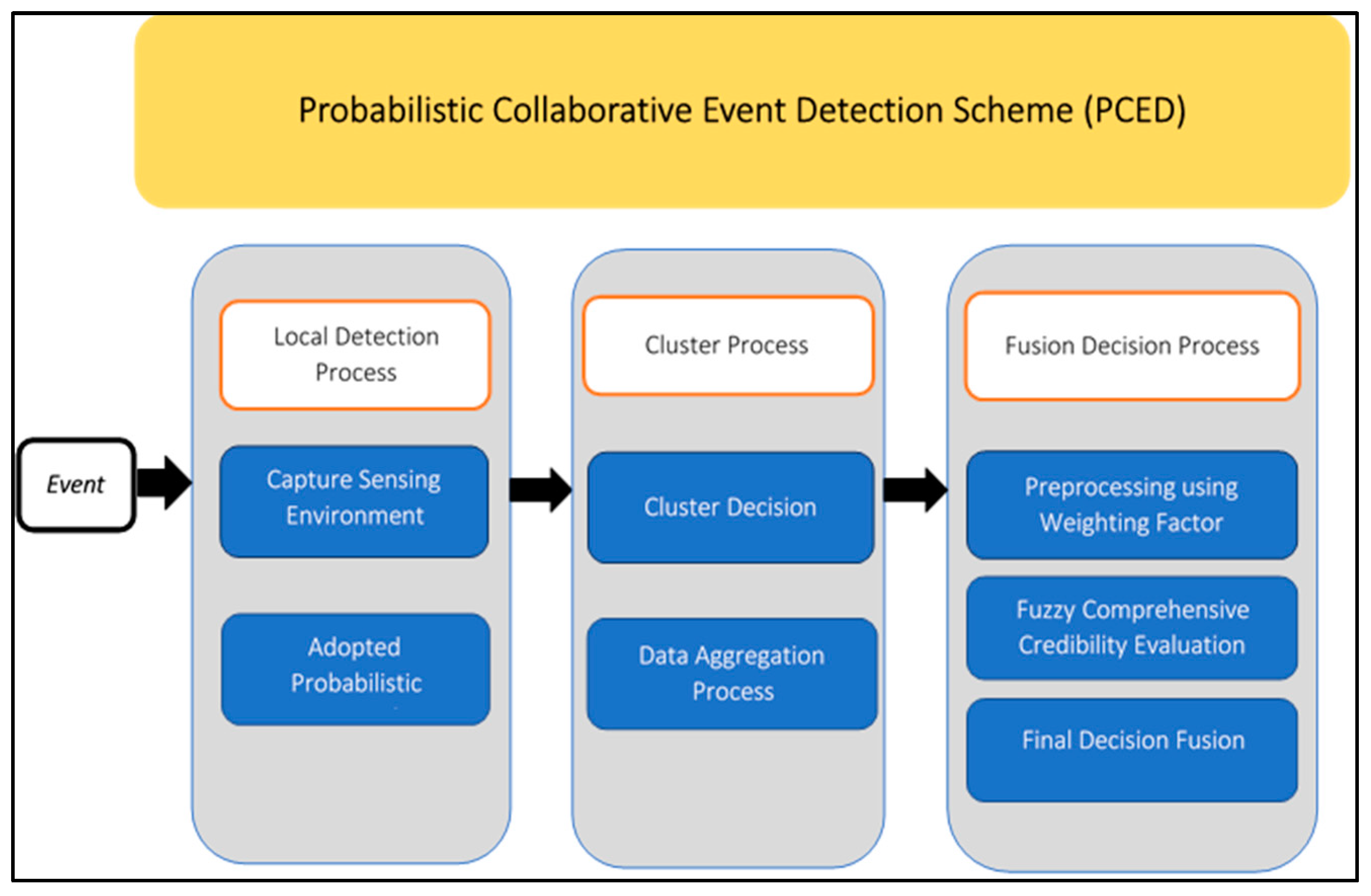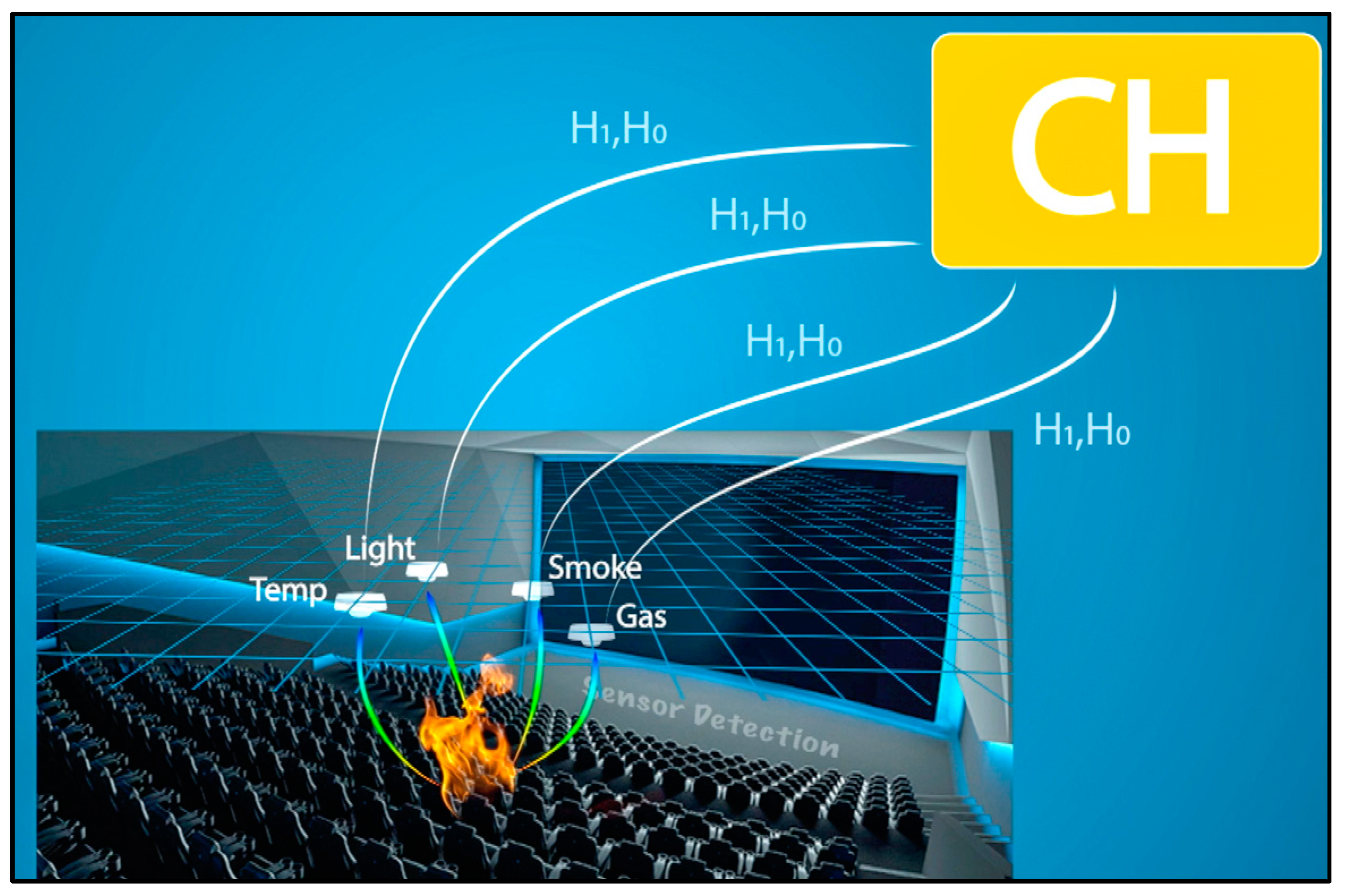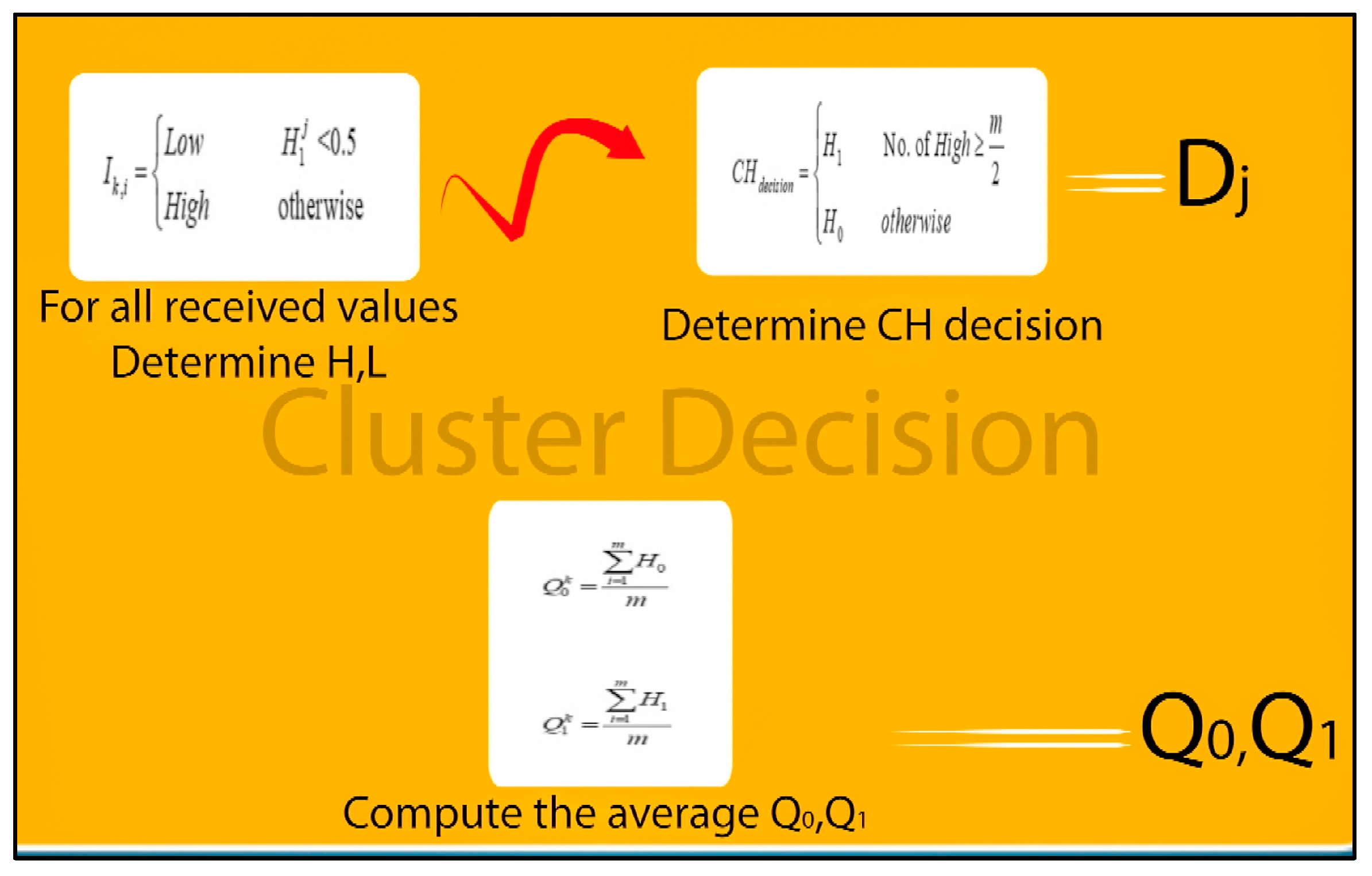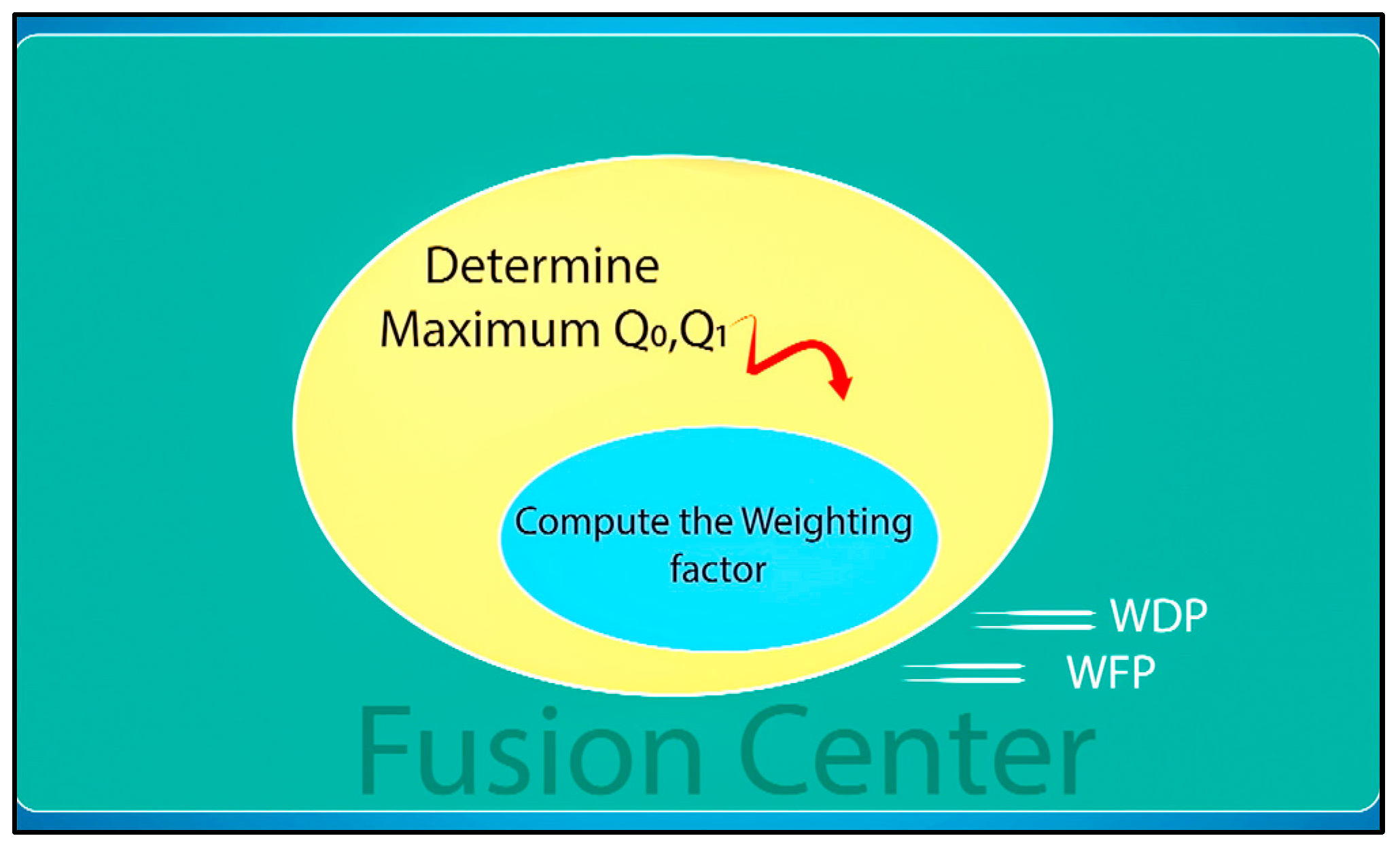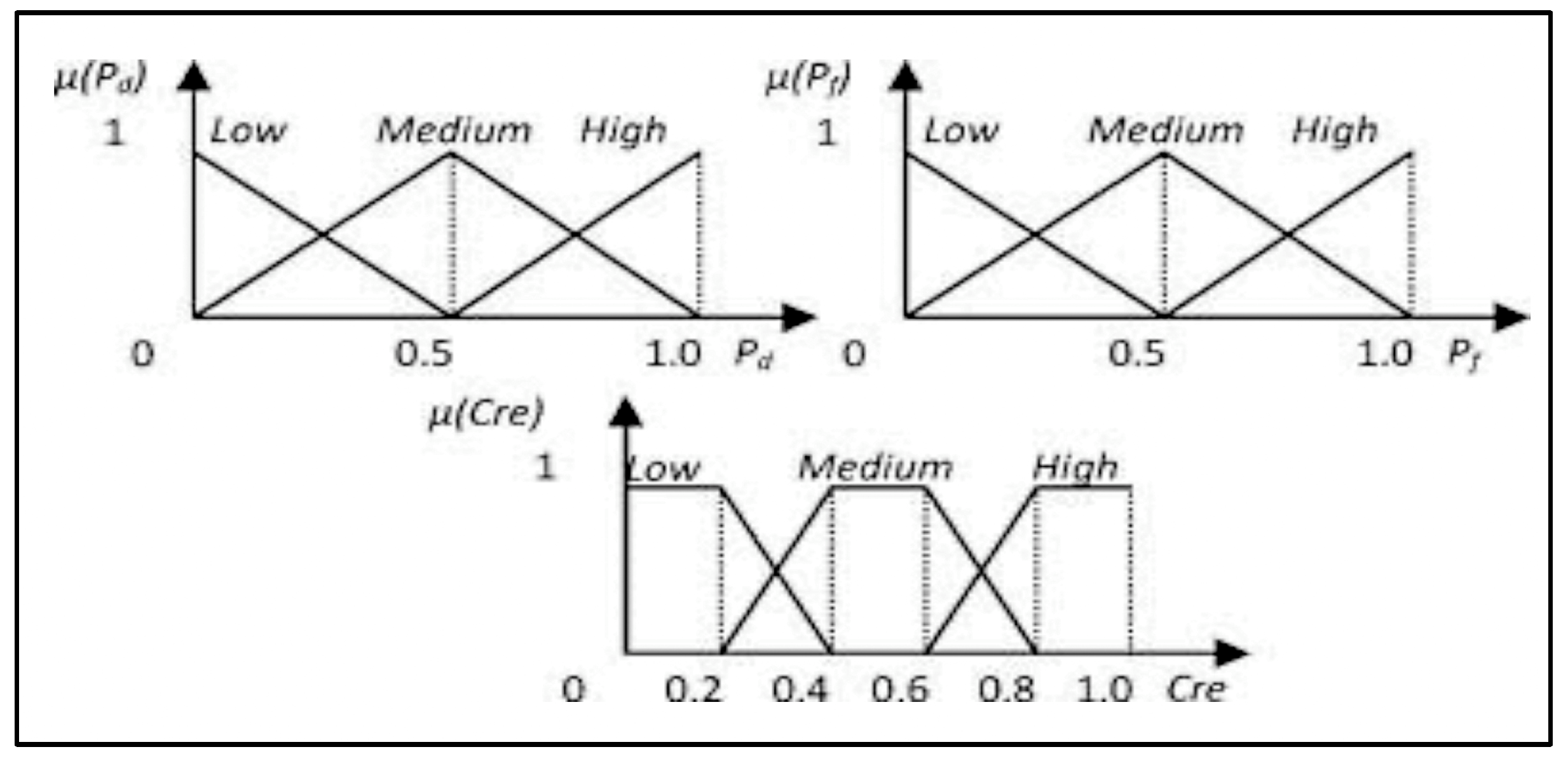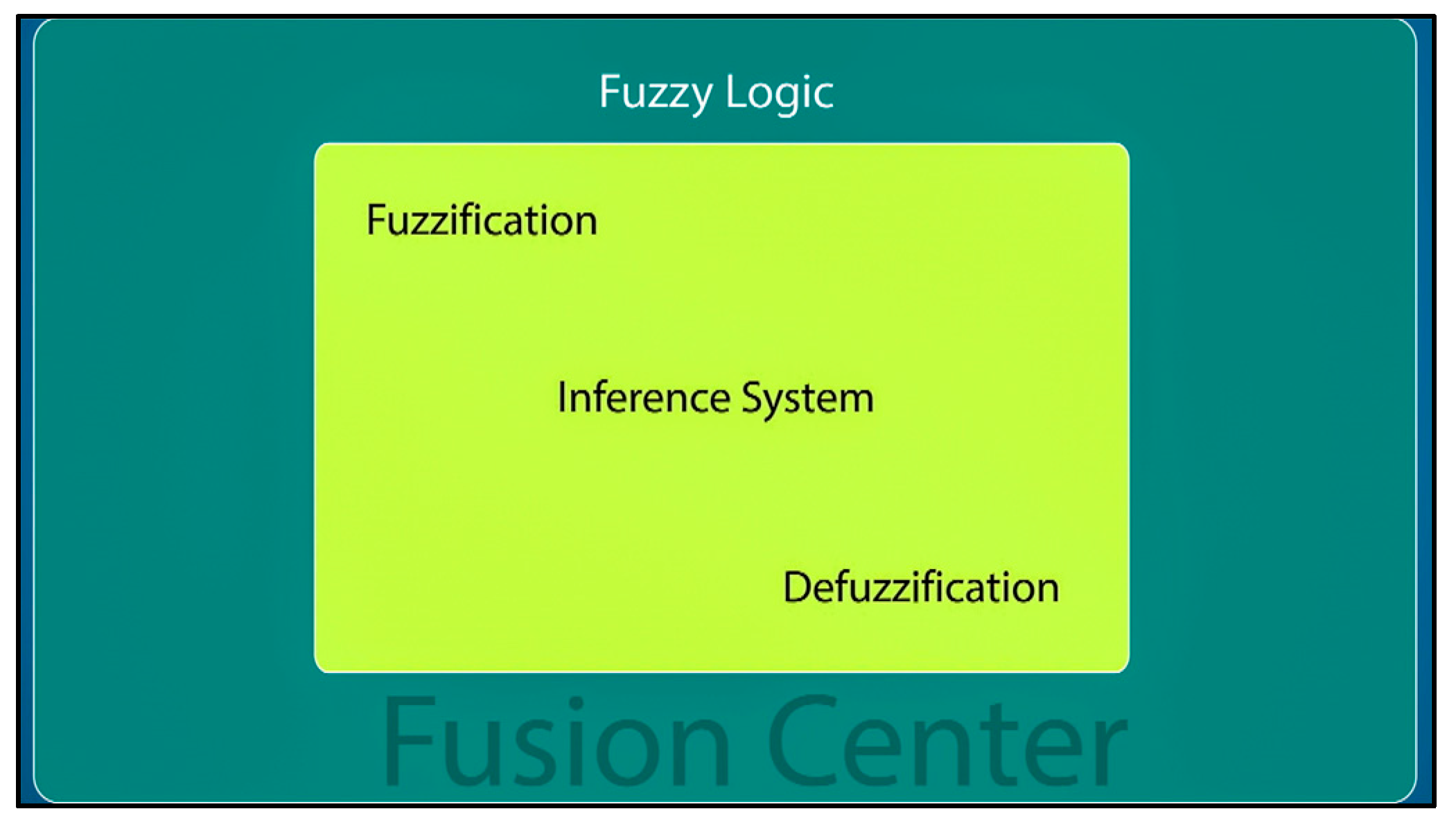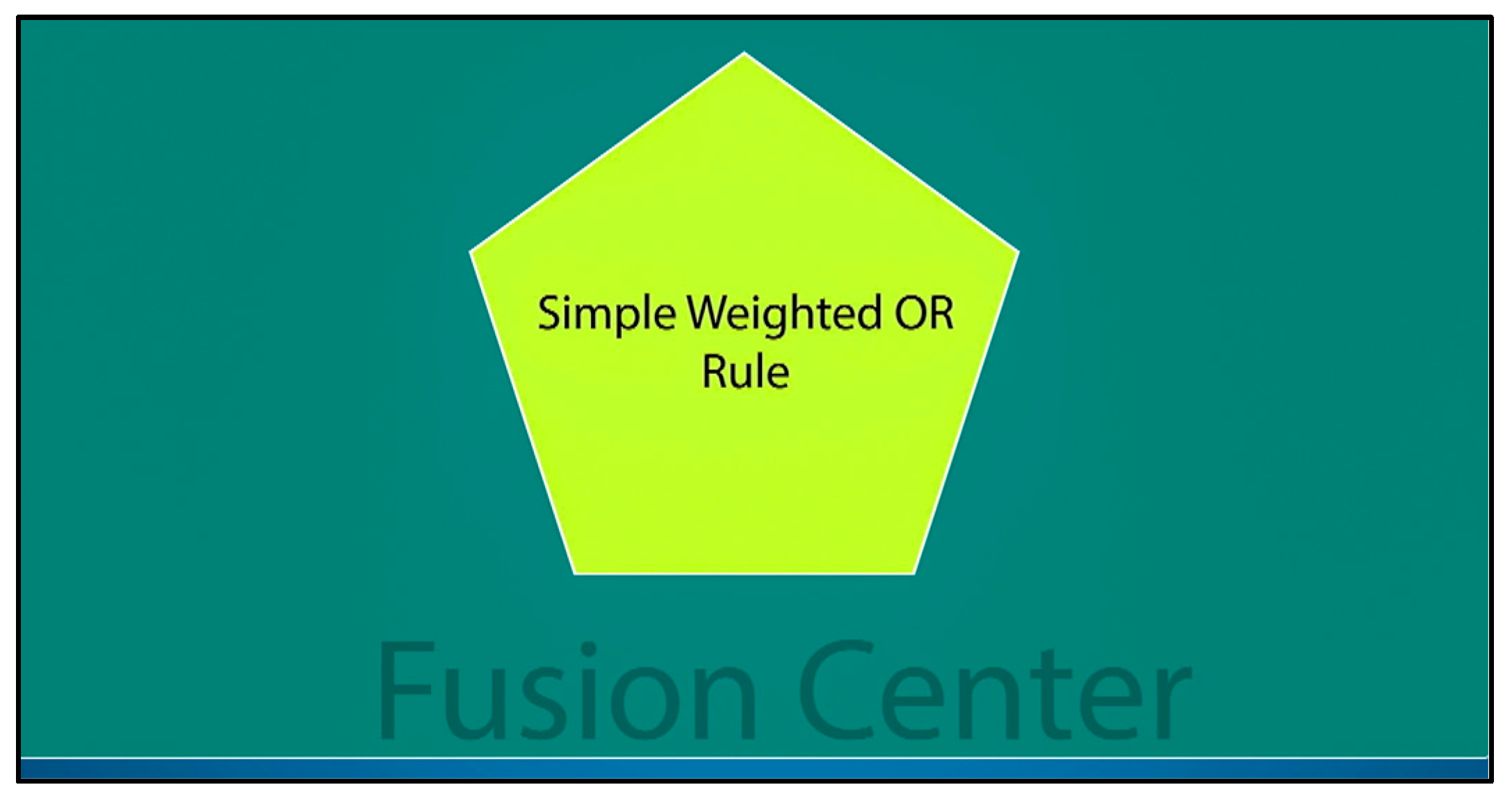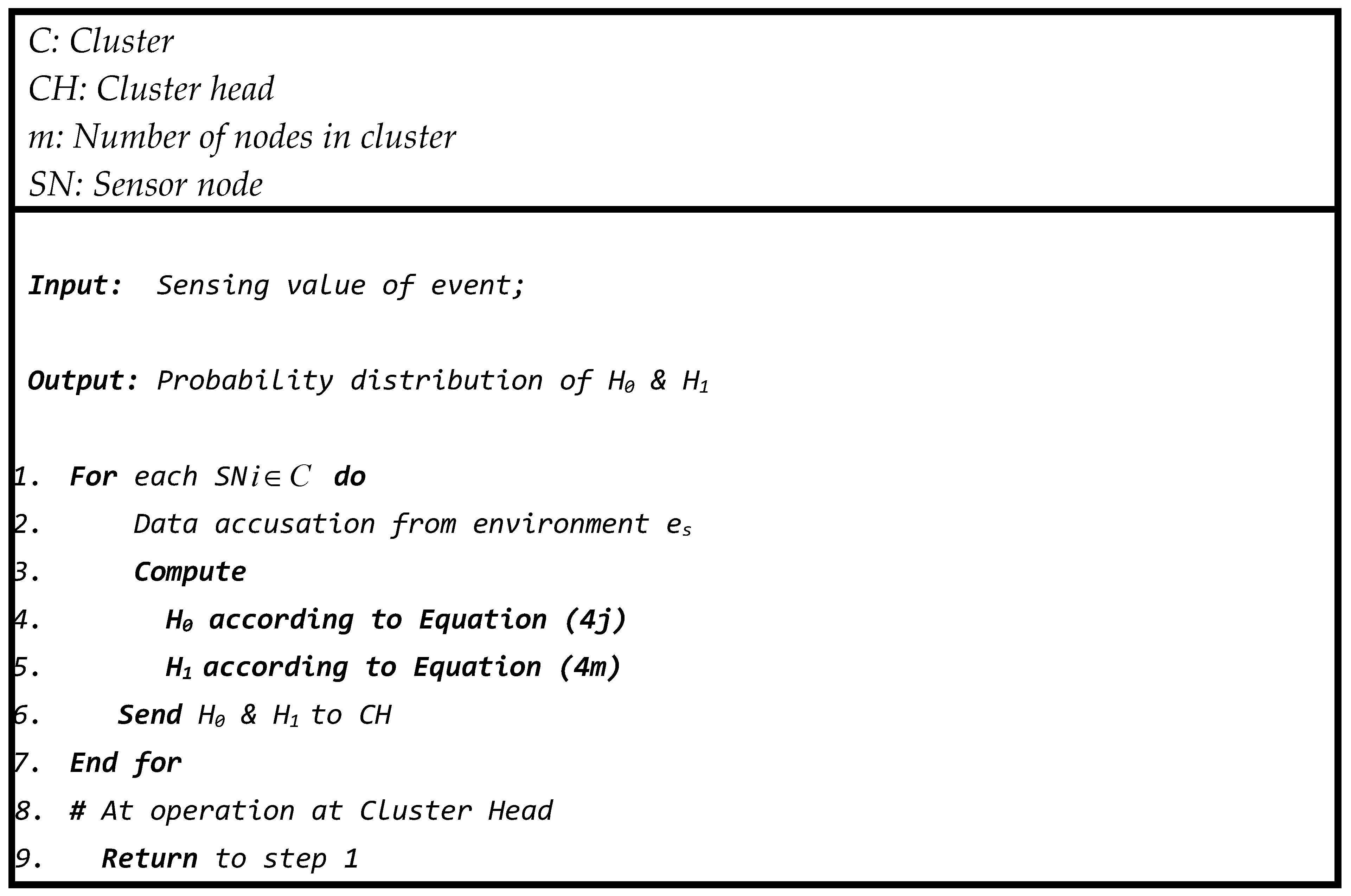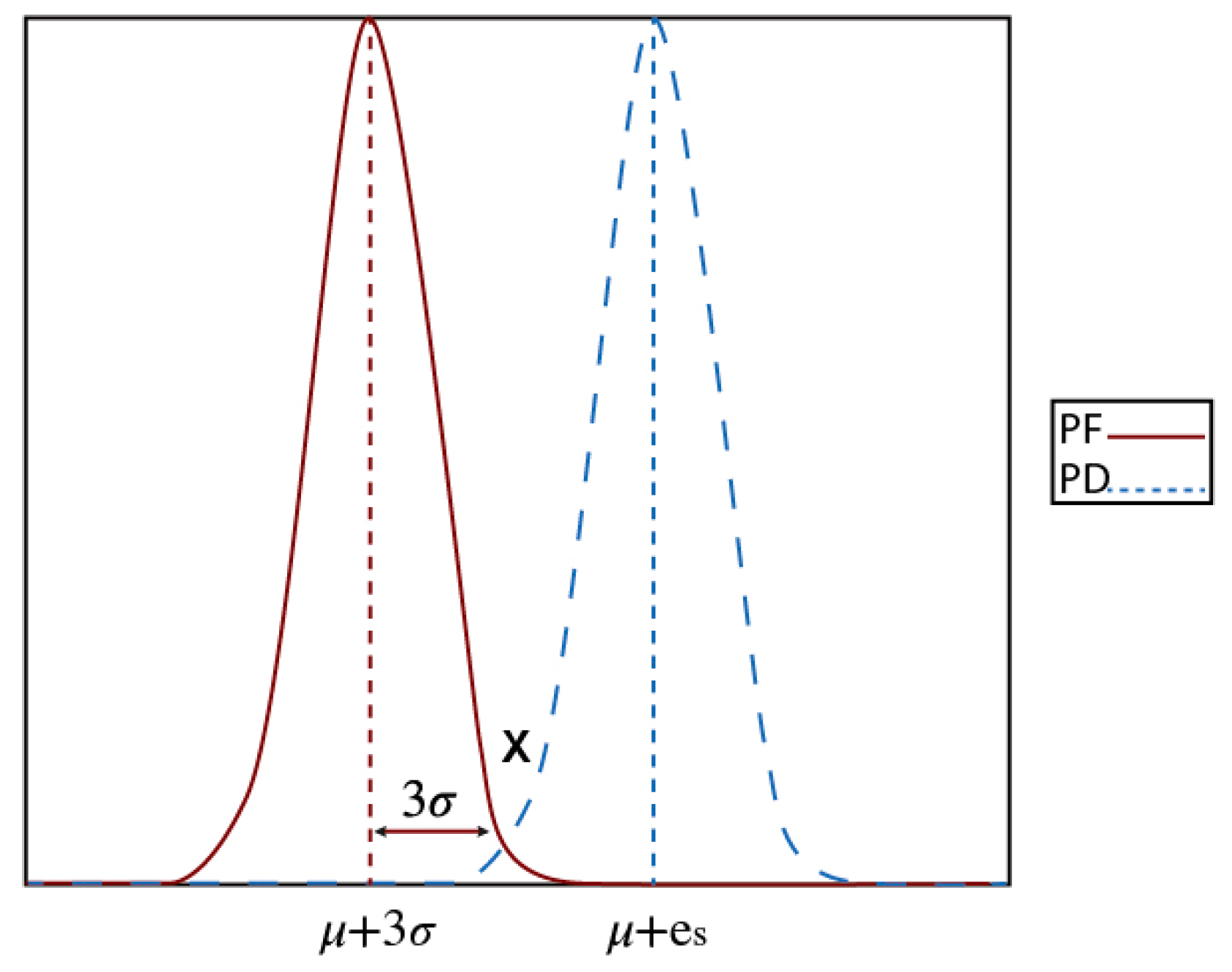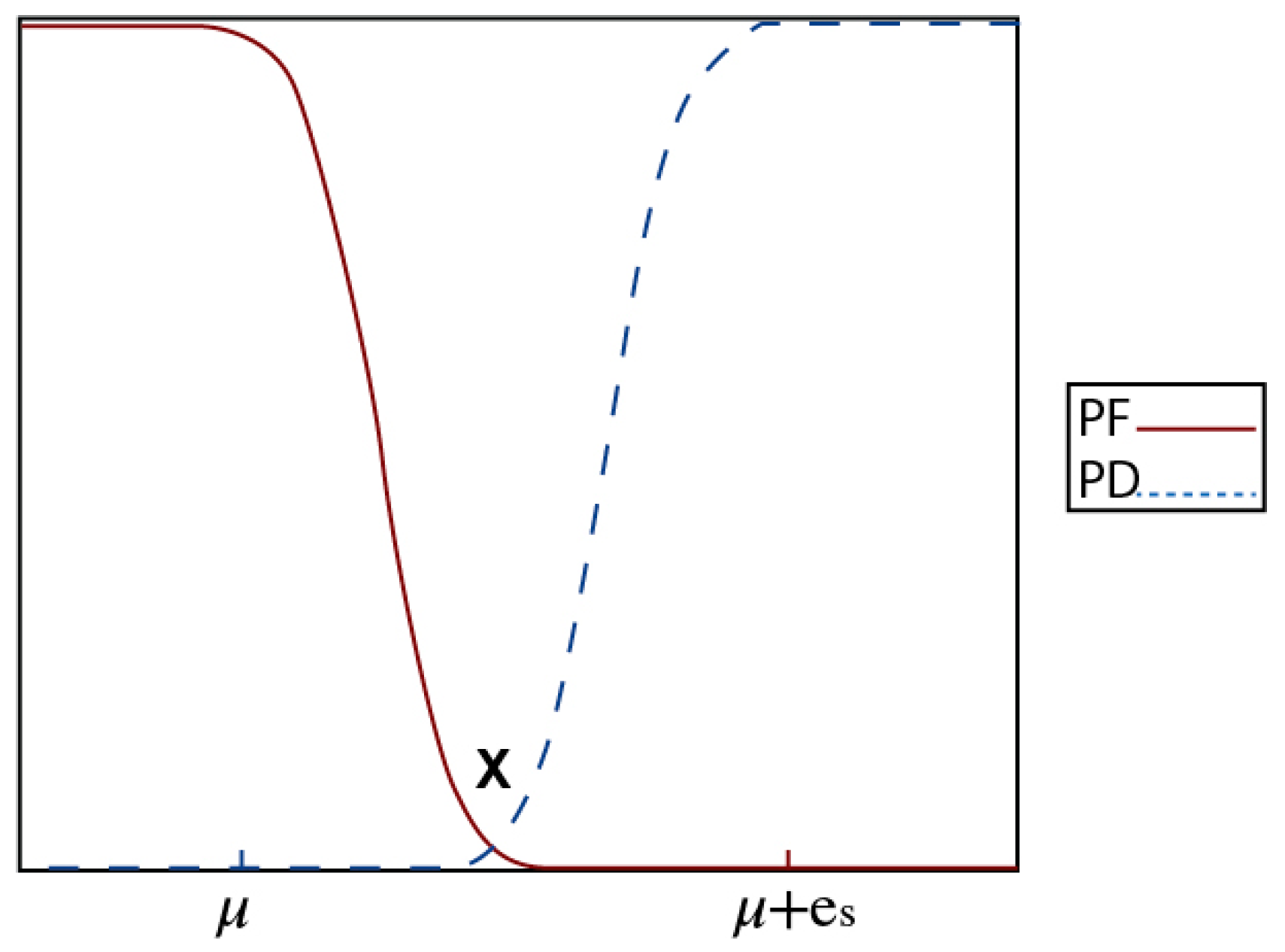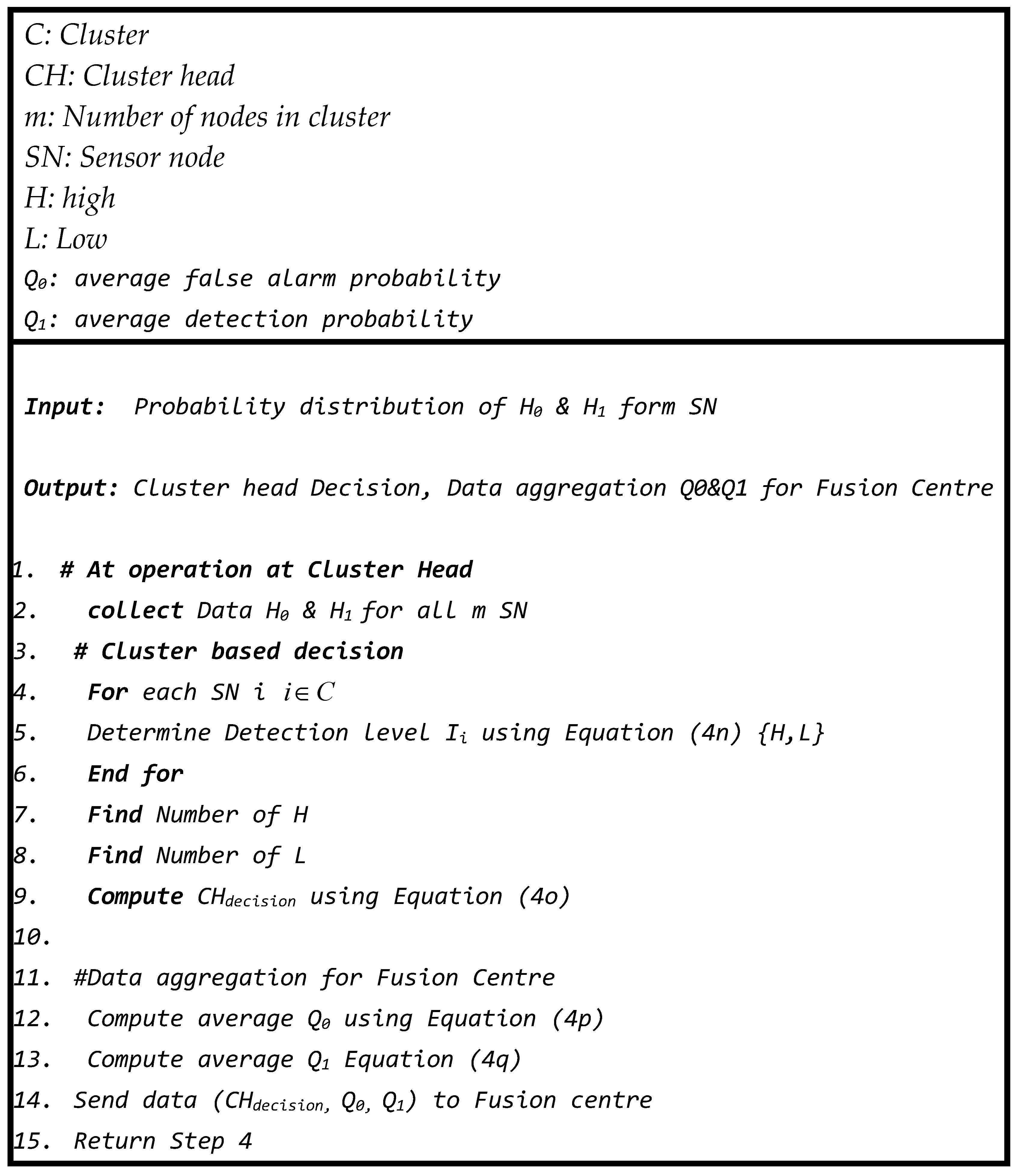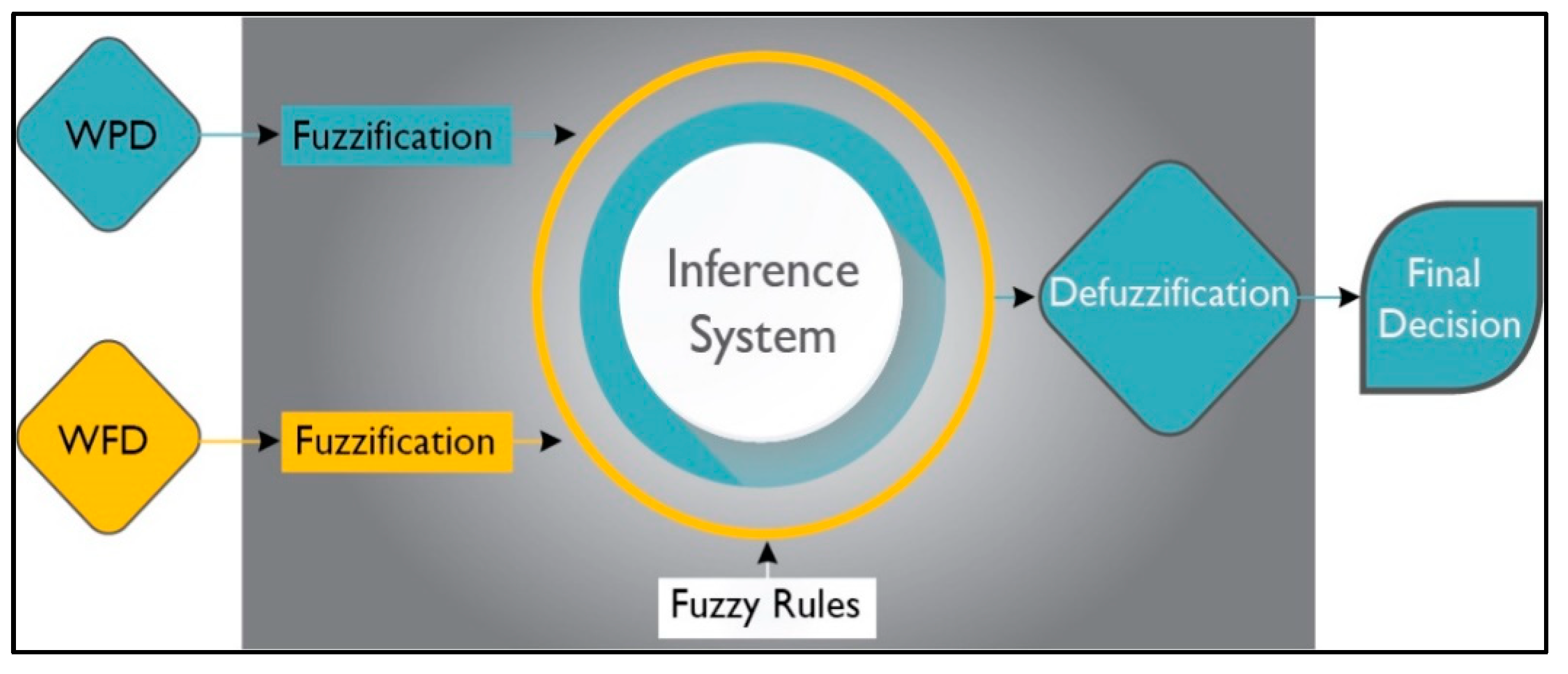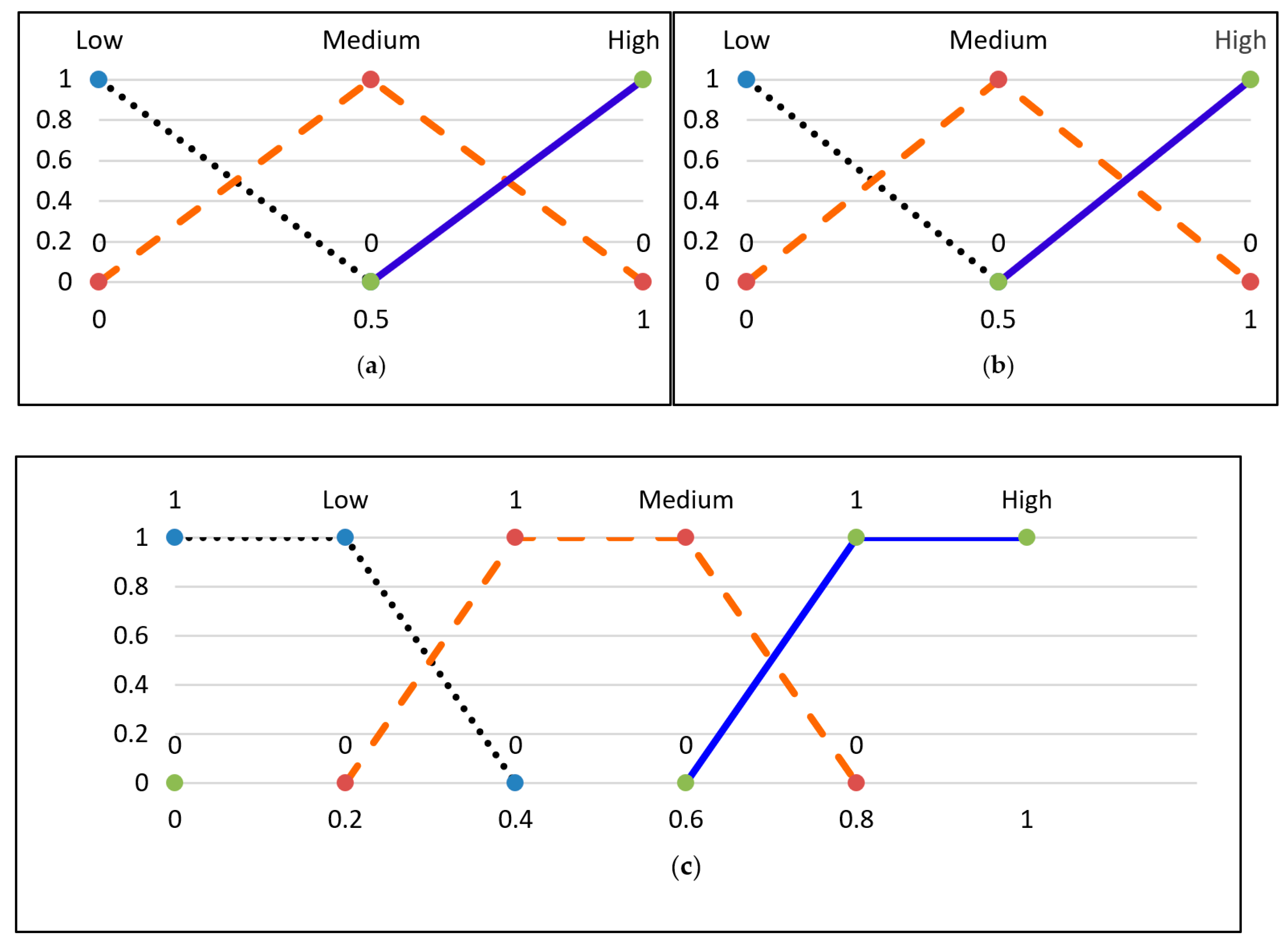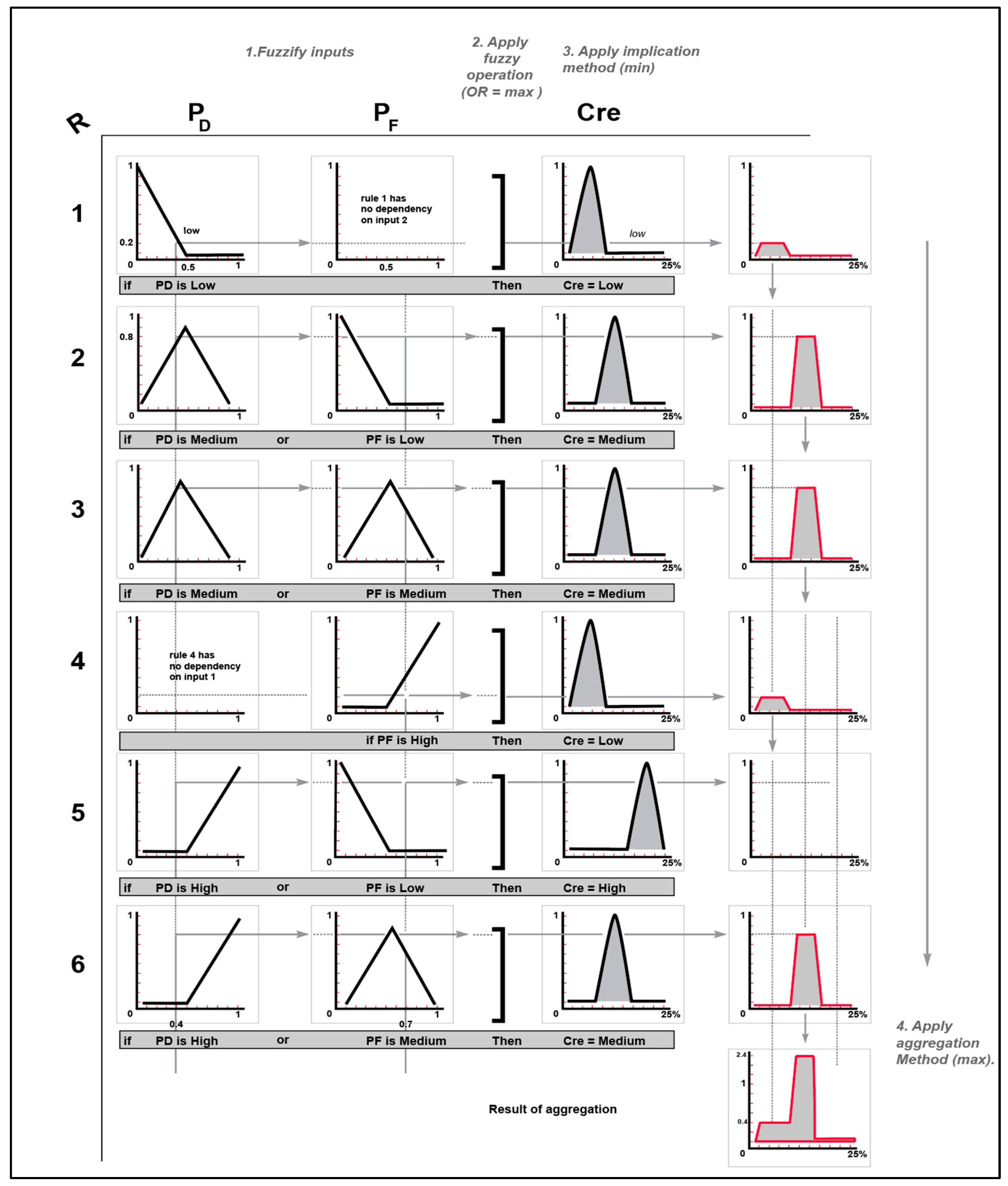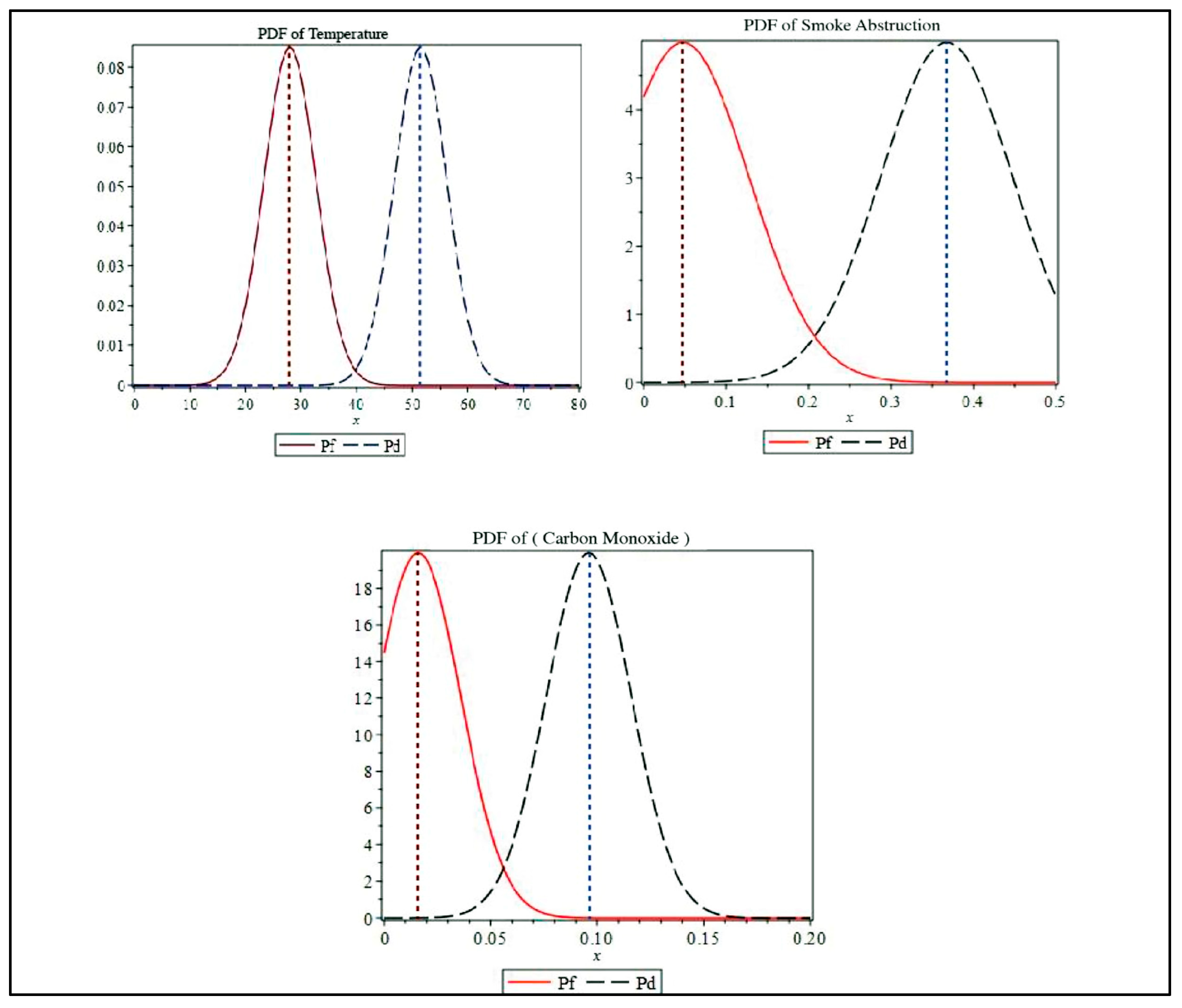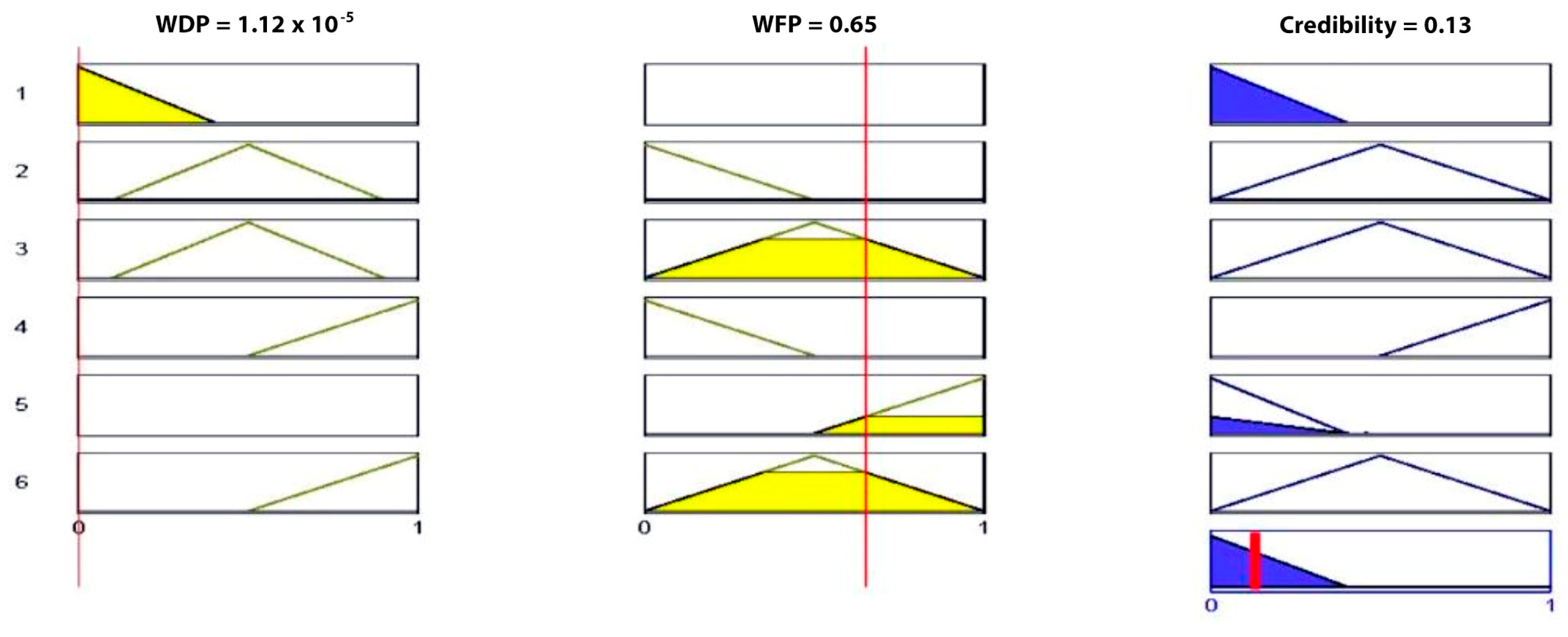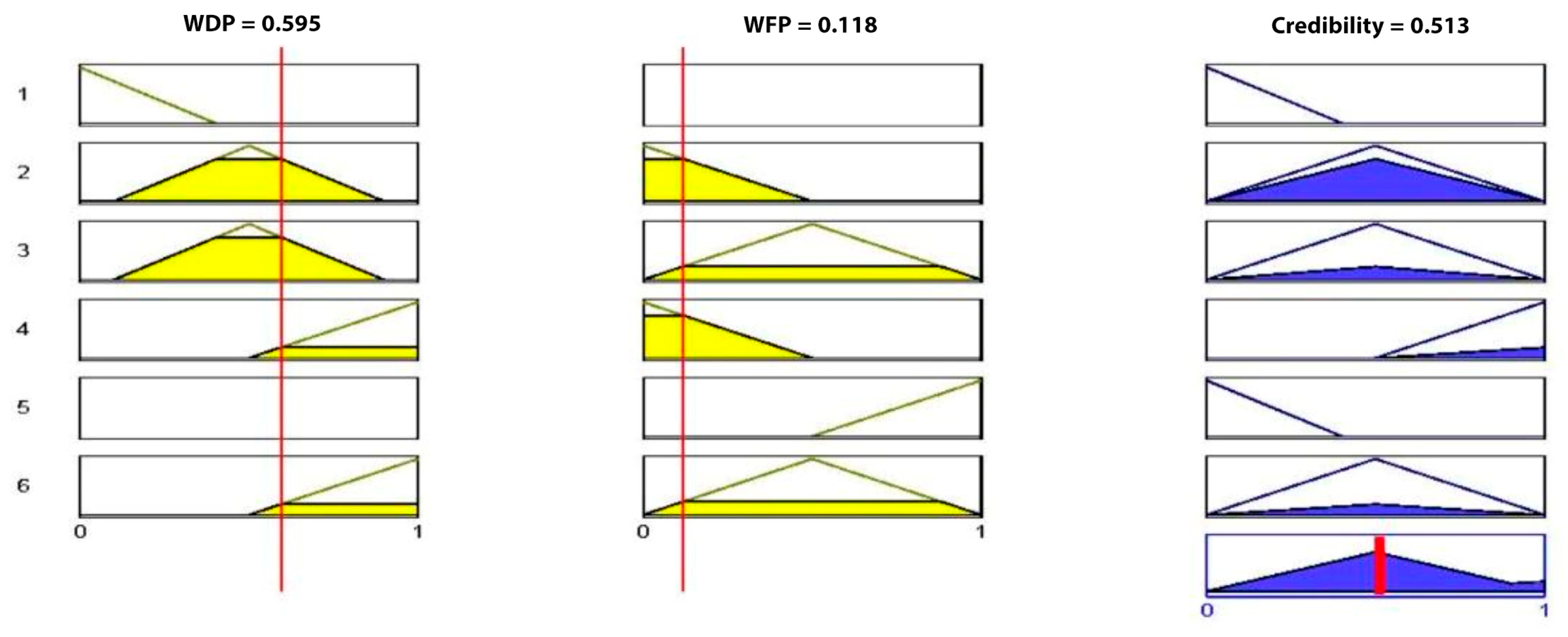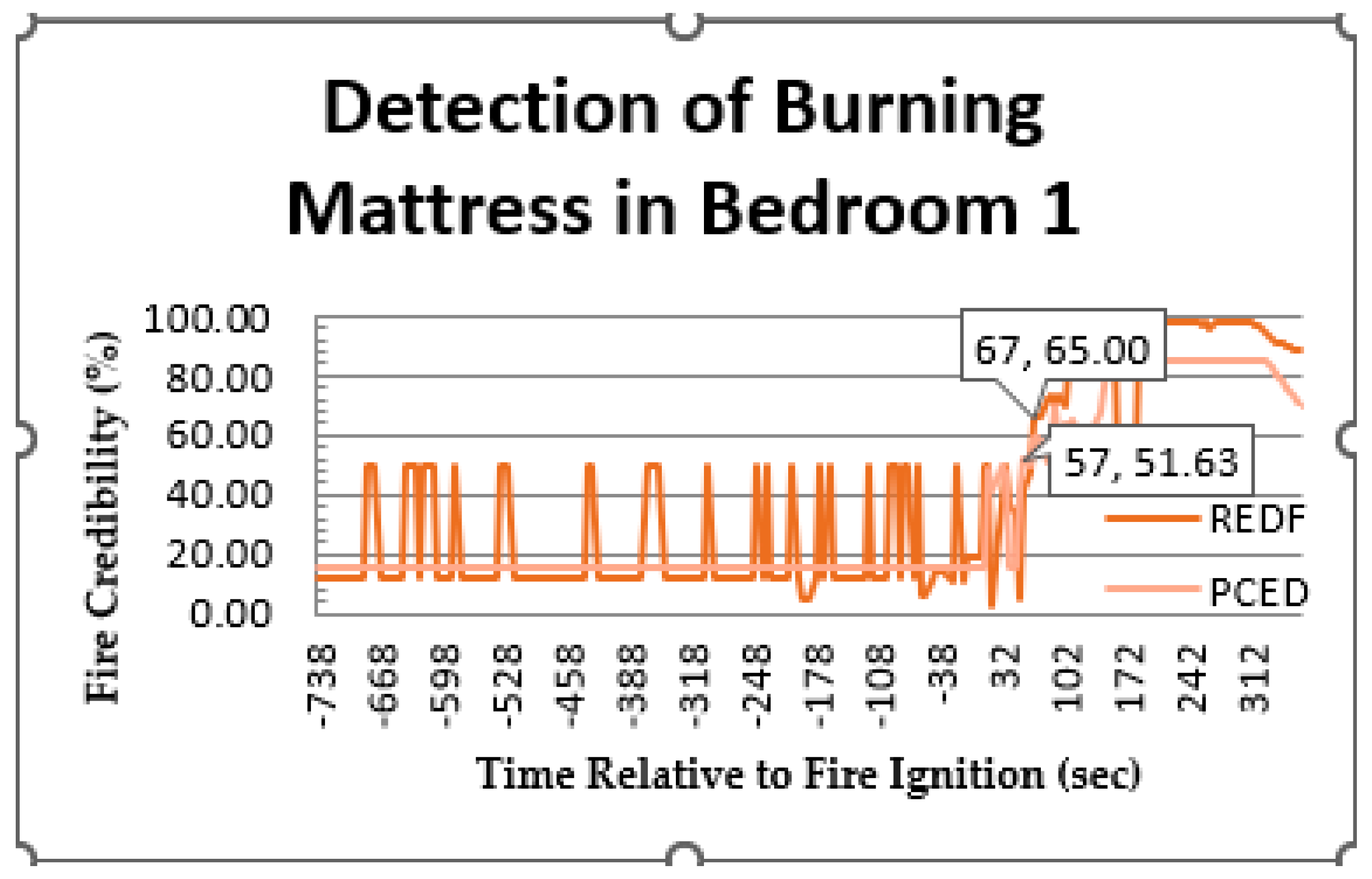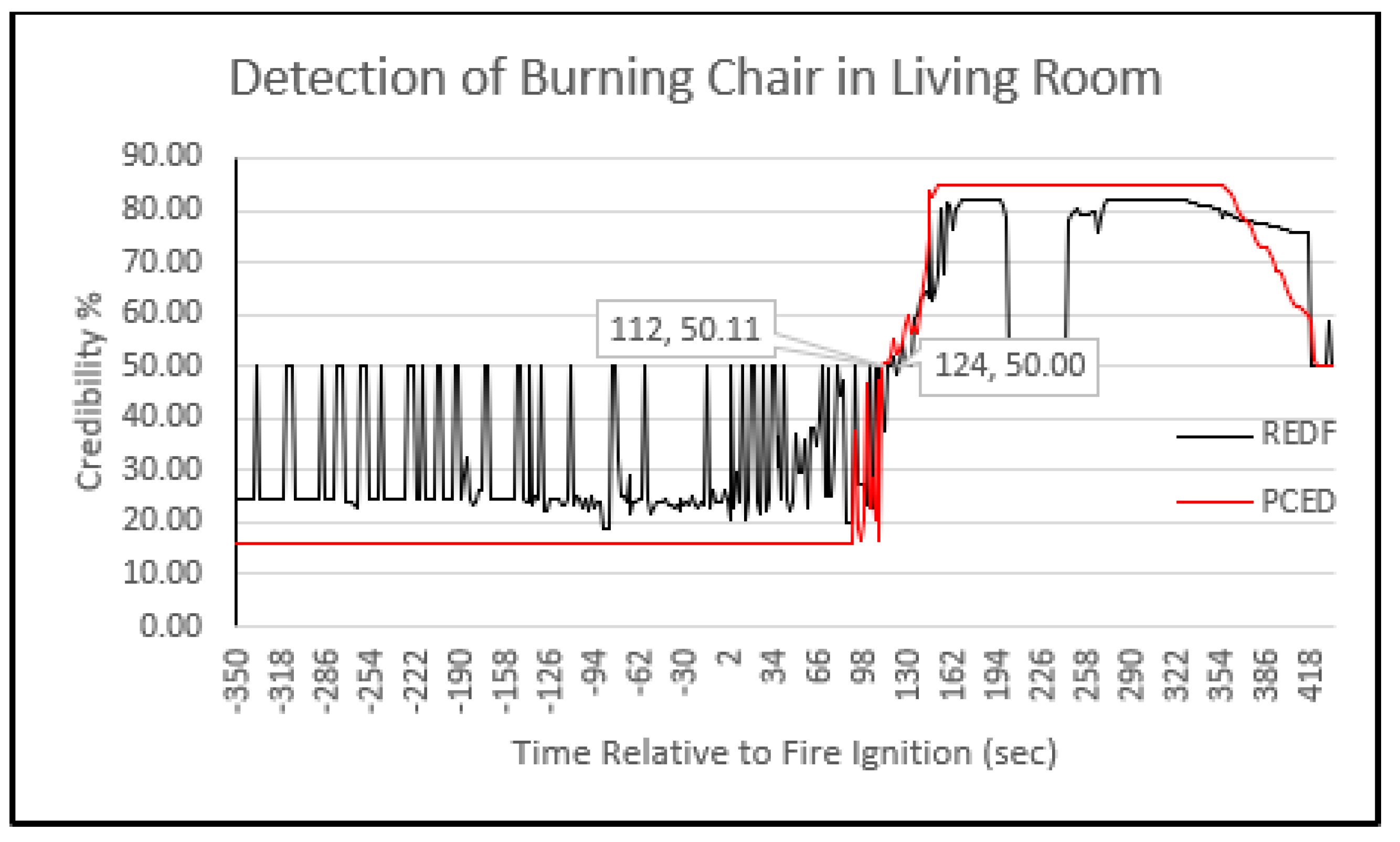This study utilizes the advantages of existing related works by using a hyper probabilistic approach to convert the measured value at the sensors into a probability instead of directly using the value for the final decision in the fusion center. The CH plays a key role in gathering the measured values from sensors that are in the cluster to perform cluster-level decisions and aggregate the data to be sent to the fusion center. At the fusion center, the input data are improved by proposing weighting factors based on the performance of fuzzy logic. In terms of network topology, a cluster-based WSN structure was considered in this study in which the monitored area is divided into sub-areas and groups of sensor nodes monitor these sub-areas. The designed approach suggests adopting the probabilistic approach and modifying it to be suitable for event detection. Heterogeneous sensors are used in this research to achieve the designed objective which require different design requirements such as mean, variance, and threshold values. Using different types of sensors can help the detection mechanism in terms of detection accuracy and the confidence in an event being present or absent.
4.1. Probabilistic Model for Local Detection Design
Following the design methodology described in
Section 3, due to the advantages of using probabilistic models in event detection, this subsection describes the probabilistic model in a heterogeneous WSN in which different types of sensors can be used to improve the event detection mechanism in terms of accuracy and detection efficiency. The use of different types of sensors is inspired from the hypothesis that using heterogeneous sensors in many event detection mechanisms is advantageous because more than one type of sensor can detect the same event and thus corroborate it. For example, a fire event usually occurs with a combination of a high temperature, i.e., detected by temperature sensors, a high level of smoke, i.e., detected by smoke sensors, and a high light intensity, i.e., detected by light sensors. This study proposes that all different sensor modalities should be located close to each other so that they are approximately the same distance
d from the event. Indeed, sensors perform detection by measuring energy emitted from the source of an event, and this energy attenuates with distance from that source. Thus, the signal energy received by sensor
i at a distance
di from the source of an event is computed using Equation (4a) [
11]:
where
is the energy measured at a distance
d0, and
is the attenuation factor of the emitted energy from source of the event with a distance di for sensors of type
j. The formula of
mainly depends on the propagation behavior. The PCED mechanism is mainly proposed for indoor environments and, to the best of our knowledge, Equation (4a) has been used in several existing studies in the field of event detection in indoor environments; thus, Equation (4a) should use the same attenuation factor values for all types of sensors, and the received energy as the signal attenuation is a function of distance. In addition, further study should be conducted to study the behaviors of different sensing modalities. Sensor measurements in a normal situation (the absence of an event) are contaminated by thermal noise (additive random noise) from the environment and the sensor itself. Thus, for each sensor of type
j, based on the hypothesis of the absence of an event
or the hypothesis of the presence of an event
and according to
Section 3.1, the energy at a sensor follows a Gaussian distribution, with a mean value equal to µ and a variance equal to
σ2. Therefore, for different types of sensor nodes used in the monitoring area, the total measured value of the sensing signal at sensor
i for sensing type
j can be represented by adopting Equations (4b) and (4c) as follows:
In this paper, (
) indicates the values of a situation in which an event is absent, and it also represents a normal range of values such the temperature for an indoor room. Equations (4b) and (4c) can be applied in the probability density function (PDF) formula of a Gaussian distribution. Thus, the PDF of the sensing measurements at sensor
can be expressed as follows:
In traditional event detection, sensors compare their signal energies to a fixed threshold λ to determine the presence or absence of an event. If the signal energy exceeds λ, the sensor outputs a value of 1 to indicate the presence of an event; otherwise, it outputs 0 to indicate the absence of an event. However, to make event detection more accurate and realistic, probabilistic techniques are used. With this technique, sensor nodes convert their detection results into probabilities that indicate the likelihood of an event being present or absent. These probabilities are then sent to the corresponding CH. To accomplish this, two probability distributions ()) are employed. The likelihood of making a positive determination regarding the existence of an event in the absence of one is referred to as the false alarm probability. On the other hand, a true alarm (detection probability) is the probability of making a positive determination when an event is present.
We can express the probabilities of false alarm detection and true detection for a sensor
i, denoted by
and
, respectively, for a sensing type
j, by utilizing Equations (4d) and (4e) as follows:
Equations (4f) and (4g) indicate that a measurement value closer to the event for a sensor type j can lead to a higher probability of detection and a lower likelihood of a false alarm. In these equations, the symbol represents the threshold value for a sensor type j, while (·) denotes the probability formula.
Through the substitution of Equations (4d) and (4e) into Equations (4f) and (4g), respectively, we obtain the following:
Each sensor transmits this information to its corresponding cluster head to facilitate the subsequent decision-making process.
The following pseudo-code (
Figure 8) is performed at every sensor node in the network according to the operational description of the probabilistic approach to convert the sensing value into a probability. Each sensor sends this information to its corresponding cluster head for further decision process.
4.2. Cluster Head Decision Making and Data Aggregation
The
CH receives the computed detection probability (
) and false alarm probability (
) for each sensor from all its member sensor nodes. Most of these probabilities received from the sensor nodes within cluster
k are used to make a decision at the
kth cluster head. The node deployment is uniformly distributed across all clusters so that each cluster head node receives m detection probability values (
Ik,1,
Ik,2, …,
Ik,m), where m represents the number of sensor nodes participating in the cluster. At the cluster heads, the received probabilities of
H0 and
H1 can be expressed as follows:
In reference [
10], a theorem is presented that states that if the attenuated signal energy (
di) from the target received by a sensor
i is greater than six times the noise variance
σ, then its local false alarm probability will be no greater than approximately 0.1%, and its local detection probability will be no less than approximately 99.9%. This theorem can be quite useful in determining the relationship between the two probability density functions (PDFs) of
H0 and
H1 for single-sensor detection, as illustrated in
Figure 9. In this figure, x represents the intersection point between the two PDF curves, and
ei(
x) is the measured value at
x. As a general trend, the probability of a false alarm decreases as
ei increases until it reaches
x (which is approximately 0.1%). Conversely, the detection probability increases proportionally to
ei for all values greater than
x. If any of the
ei values are less than
x, then an event is considered absent, and the decision of event (1) is considered a false alarm.
Based on the characteristics of the Gaussian distribution, if the false alarm probability is expressed as the probability of
ei being greater than
x, then it would be less than approximately 0.1% if
x is larger than
µ + 3
σ [
9] for Pf(
ei(
d) >
ei(
x)). Here,
µ and
σ represent the mean and the standard deviation of the noise, respectively. Conversely, if an event is present, Pd(
ei(
d) >
ei(
x)) can be greater than approximately 99.9% under the same condition of
x.
Based on the correlation between the PDFs, the connection between
x and
di can be expressed as follows:
To ensure that the probability of false alarms is kept below 0.1% at position
x, the value of
ei(
x) needs to be adjusted to be higher than
µ + 3
σ.
It should be emphasized that in an event detection system, an increase in the measured value at the sensor leads to a higher probability of detecting an event. Consequently, the probability of detection
PD(ei) at position x is roughly equivalent to the probability of a false alarm
PF(ei).Nevertheless, the condition mentioned above is not evident in Equation (4l), which indicates that
PD(ex) exceeds 99.9% for all values of
ei less than
ex but declines for values greater than
ex. Consequently, it is necessary to revise Equation (4l) to comply with the design specifications that require the detection probability to increase with the sensing value. As a result, the equation for
H1 should be written as follows:
Consequently,
Figure 10 portrays the false alarm and detection probabilities at the sensor level, which are derived from Equations (4j) and (4m).
The decision-making process at cluster CH employs probability information from the sensor readings to arrive at accurate decisions. To design the decision-making mechanism at CHk, a rule-based approach was utilized. Typically, the likelihood of an event occurrence is strengthened when multiple nodes report elevated readings from the same sub-area. As a result, this supports the hypothesis that various sensors detecting high values indicate the presence of an event. This study proposed a rule-based approach for event detection at CHs.
Indeed, increasing the number of granularity levels (such as very low, low, …, high, and very high) may potentially enhance the accuracy of a system. However, in a resource-constrained environment like a WSN, the designer of an event detection system must reduce the number of membership sets to maintain accuracy while minimizing the complexity of rules and memory usage. To implement these rules, the probability values received from the sensors are translated into two levels: high and low. The range of values (0–1) in the distribution is split into two levels using the following approach:
As each cluster employs distinct types of sensors, the decision at a
CH can be based on the majority rule. If m denotes the number of sensors in each cluster, a
CH requires at least half (
m/2) of the sensors reporting high values to confidently confirm the occurrence of an event. This can be expressed as follows:
where
CH decision refers to the decision made at the
CH.
If
A indicates the presence of an event and
represents the present measurement value obtained by a sensor
i, the value is computed for each value in the r-level set that includes N different values for both
H0 and
H1. Here,
i = 1, 2, …,
m, as there are m sensors in the cluster. Assuming an event is absent under the hypothesis
H0, the estimated probability
Q0 represents the likelihood of the cluster receiving readings from its m sensors (false alarm). Assuming the hypothesis
H1 is true and an event is present,
Q1 denotes the cluster probability of sensors collecting their own data. The aim of this method is to determine a shared detection probability and false alarm probability for all sensors in the cluster. Hence, the detection probability and false probability for a cluster
k can be determined through the following computation:
The following pseudo-code (
Figure 11) is executed at every
CH node in the network according to the operational description of the probabilistic approach of the sensor node to convert the measured value into a probability.
The CHs send their Q0 and Q1 estimates to the fusion center for further detection and final decision making. The data from the clusters are gathered at the fusion center and fuzzy logic are employed to make the final decision. However, it should be noted that different clusters may have varying data values depending on their distance from the event source. As such, this factor should be considered during the development of the fusion center and in the final decision-making process.
4.3. Pre-Processing and Aggregation of Data
The distance from the source of the event greatly affects the decisions made by the sensor nodes and their corresponding CHs such that clusters located closer to the source of the event have higher detection probabilities with a greater confidence and weight. To account for this, this study proposed the use of a weighting factor for each cluster that reflects the significance of its data readings in the final event detection decision. The weighting factor can be obtained through the following formula.
Identify the detection probability with the highest value:
where
NC represents the total count of clusters.
The weighting factor for each cluster can be calculated based on the mean distance vector for a cluster
k using the following formula:
The weighting factor can be expressed as follows:
By examining the equation above, we can see that the highest weight that can be allocated to a cluster is determined as follows:
The minimum weight can be determined in cases in which the sensor nodes in a cluster are far from the event and cannot measure any data, resulting in an approximate detection probability
of 0. This can be expressed as follows:
Hence, the range of weighting factors can be defined as follows:
The same procedure can be applied to obtain the weighting factor for the false alarm probability, which can be expressed as follows:
The range of the weighting factor
for the false alarm probability can be expressed as follows:
The utilization of weighting factors and can enhance the effectiveness of fuzzy logic by limiting the number of inputs to just two, which in turn reduces the complexity, particularly during the fuzzification process while applying the membership function and set of fuzzy rules. The proposed modification can potentially improve the accuracy of event detection by considering the decision made by each cluster, which is weighted by the assigned factor, in combination with the decisions from all other clusters in the monitored area.
The fusion center receives inputs consisting of the detection probability
and false alarm probability
, along with the
CH decision. These inputs are then processed to obtain the weighted detection probability (WDP) and weighted false alarm probability (WFP). The equations for calculating WDP and WFP are as follows:
The weighting factor can provide a greater weight to the cluster with a higher detection probability, ultimately leading to fewer false alarms.
4.7. Fire Detection Procedures and Numerical Example
According to the proposed event detection structure, the detection mechanism consists of three major parts: (i) sensor-level detection; (ii) cluster head detection; and (iii) fusion center. For sensor-level detection, four types of sensors (smoke (S), temperature (T), light (L), and gas (G)) were deployed in each sub-region. The following procedures were used in the case study according to the designed event detection mechanism.
Sensor nodes send their measured data to their corresponding cluster head. Thus, the detection probability
H1 and false alarm probability
H0 information at the cluster head (after solving the
Q Function and its equivalent error function as a complementary CDF using Equations (4j) and (4m)) can be presented as follows:
Table 3 illustrates the mean values and variances of different types of sensors according to data presented in the NIST dataset [
26].
The PDFs of the three sensor values (shown in
Figure 16), which were obtained from the Test 5 datasheet from NIST, illustrate the designed PDF for detection probability and false alarm probability.
For instance, two reading values (one before the fire event and the other after the ignition of the fire) can be used to understand the behavior of the designed model. For this example, Maple software was used to solve the equations and obtain the following results.
Case 1 (no fire): Temperature (22.4 °C), smoke obstruction (0.0205%/m), and CO (0.0151). By applying Equations (4B) and (4C):
Temperature: (H0 = 0.703456810, H1 = 6.140 × 10−7);
Smoke: (H0 = 0.8026330517, H1 = 6.784 × 10−7);
Carbon Monoxide (CO): (H0= 0.5179463455, H1 = 0.261616 × 10−4).
Case 2 (fire): Temperature (51.9 °C), smoke obstruction (0.482%/m), CO (0.0235).
Temperature: (H0 = 1.837 × 10−7, H1 = 0.8610627296);
Smoke: (H0 = 2.70 × 10−8, H1 = 0.9247120136);
Carbon Monoxide (CO): (H0 = 0.1444808 × 103, H1 = 0.3538302334).
At the second phase, a decision is made at the CH such that a positive detection of an event is signaled as soon as enough sensors have a high detection probability; at this phase, the decision mainly depends on high detection values that are received from the majority of local sensors. Accordingly, in the proposed model, every sensor type will send PD and PF values to its corresponding CH. Hence, the CH converts these values into linguistic terms (Low or High) based on Equation (4n). Then, the decision at the CH is positive if two out of three sensors have a detection probability that is High, for instance, temperature and smoke or CO and smoke. Thus, the decision will be as follows:
Case 1: All three sensors are determined to have a High false alarm and a Low detection probability, so the decision at the CH is H0 (no fire).
Case 2: Two sensors (temperature and smoke) have High detection, so the decision at the CH is H1 (fire).
Fusion Centre: the level is applied in the fusion center as described below.
At this stage, the WDP and WFP are computed by applying Equations (4z) and (4A); for this numerical example, only one cluster is considered, so W is equal 1 and therefore, WDF = Q1 and WFP = Q0.
WDF = Q1 and WFP = Q0 were used as inputs to the fuzzy logic to determine the final decision for the cluster.
Case 1: After applying the fuzzy process and the processes of fuzzification and defuzzification (
Figure 17), the output was equal to 0.13, which indicates that there is no fire.
Case 2: In this case, the output was equal to 0.513, which indicates the presence of fire (
Figure 18).
In brief, this numerical example illustrates the operation of the proposed models for event detection and validates that the models and designed mathematical models are working properly in the cases of absence of fire and presence of fire.
